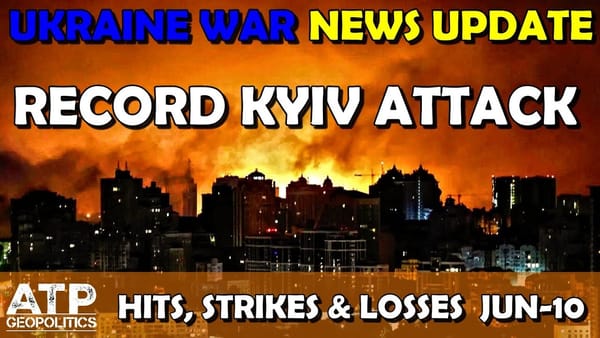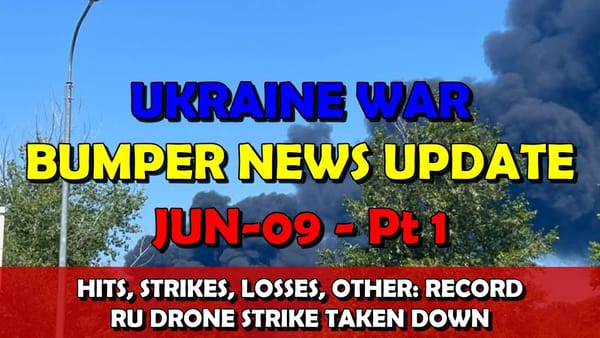Ukraine War Update NEWS: Military Aid News - Israel Delivers Patriots to Ukraine!
Table of Contents 📖
Hello Team
🎦 00:00-00:28⏩
Jonathan welcomes viewers to another ATP Geopolitics update, noting it's a military aid video. He encourages viewers to watch his previous live stream on hits and losses, particularly the unexpected segment with Andrew Perpetua discussing drone technology.
Return to top⤴️
Drone Technology Analysis with Andrew Perpetua
🎦 00:28-03:55⏩
Jonathan shares insights from Andrew Perpetua regarding Ukrainian drone technology, highlighting their strong performance and upcoming innovations. While Ukrainians have an advantage, it's less pronounced than often perceived, as Russian drone capabilities, particularly with fibre optic drones, are also advancing. Jonathan expresses hope that Ukraine's decentralised production network will allow them to quickly surpass Russian innovations once they catch up to new Russian ideas. He contrasts this with Russia's more centralised, less reactive manufacturing base, suggesting Ukraine's system is better for rapid adaptation.
Return to top⤴️
Israel Delivers Patriot Air Defence Systems to Ukraine
🎦 03:59-07:23⏩
Breaking news from Noll Reports confirms that Israel has transferred an undisclosed number of Patriot air defence systems (PAC-2 variant) to Ukraine. These systems, originally received by Israel from the US in the 1990s and now considered obsolete for Israel's needs, are helping to defend Ukrainian skies. Jonathan notes that the transfer was largely unmentioned publicly, possibly due to OPSEC (Operational Security) or the Ukrainian desire to keep it quiet. He suggests this could explain a recent significant improvement in Ukraine's drone interception rate.
Return to top⤴️
Improved Ukrainian Drone Interception Rate and Saab 340 Radar Planes
🎦 07:23-09:19⏩
The improved interception rate for Russian Shahed drones, reaching 96% in a recent attack, might be linked to the new Patriot systems. Jonathan also raises the possibility of Sweden's Saab 340 (ASC 890) radar planes playing a role. These planes, now online with Link-16 permission, can provide 400km of air coverage, significantly enhancing Ukraine's target acquisition for Shahed drones, which are often difficult to spot due to varying speeds and altitudes. The deployment of Israeli PAC-2s might allow Ukraine to move their more advanced PAC-3 systems (capable of shooting down Kinzhal missiles) to areas like Dubno Air Base in western Ukraine, where they recently downed four Kinzhals.
Return to top⤴️
French Renault Partnership for Drone Production in Ukraine
🎦 09:21-10:40⏩
Jonathan reports on a potential partnership between French carmaker Renault and a French defence firm to manufacture military drones in Ukraine. The production lines would be located a few dozen or hundred kilometres from the front lines, with Ukrainian forces providing combat experience. However, Jonathan notes that while some sources present this as a fait accompli, Renault itself has not yet made a final decision, despite being approached by the French Ministry of Armed Forces.
Return to top⤴️
Canada's $35 Million Military Aid Package
🎦 10:41-13:03⏩
Canada is providing Ukraine with a $35 million military assistance package. This includes:
- $30 million for Coyote and Bison armoured vehicles.
- New equipment and ammunition from Canadian companies, stimulating Canada's economy.
- $5 million for anti-jamming kits and electronic warfare equipment.
Jonathan adds that Canada previously transferred 64 Coyote armoured vehicles to Ukraine in December last year. He provides details on the Coyote (a reconnaissance vehicle with a 25mm chain gun) and Bison (an armoured personnel carrier) vehicles, highlighting their roles and armaments.
Return to top⤴️
Expansion of Electronic Warfare Coalition for Ukraine
🎦 13:04-14:14⏩
Five additional countries—Belgium, Sweden, Italy, Turkey, and Estonia—have joined the International Coalition of Electronic Warfare for Ukraine. Jonathan believes Turkey's involvement is particularly interesting, suggesting it indicates a realisation that participation enhances their industrial base, knowledge base, and allows them to showcase their defence capabilities to other nations. He views these capability coalitions as mutually beneficial, offering industrial advantages and valuable feedback.
Return to top⤴️
Slovakian Susana II Howitzer Deliveries and Robert Fico's Stance
🎦 14:16-15:15⏩
One or more Slovakian Susana II self-propelled howitzers are now in service with Ukraine's Karadag Brigade. While Germany, Denmark, and Norway pledged 16 of these (worth €92 million) in late 2022, only nine have been delivered so far. Jonathan attributes these delays to Slovakian Prime Minister Robert Fico's anti-Ukraine stance. He criticises Fico's "complete inconsistency," noting that Fico declares direct military aid morally wrong unless Slovakia is paid for its arms, effectively prioritising profit over moral support.
Return to top⤴️
Robert Fico on NATO Defence Spending
🎦 15:16-15:32⏩
Slovakian Prime Minister Robert Fico has publicly opposed NATO's push for member nations to spend 5% of their GDP on defence, deeming it "unrealistic."
Return to top⤴️
Germany's Consistent Supply of IRIS-T SLM Air Defence Systems
🎦 15:32-19:44⏩
Germany continues to provide Ukraine with IRIS-T SLM air defence systems, which Jonathan praises for their effectiveness (e.g., taking out eight cruise missiles with 100% accuracy in 30 seconds). He highlights their consistent flow into Ukraine, in contrast to the more challenging supply of Patriots. Jonathan also notes that new launchers are arriving, indicated by their deeper green colour (the first ones were sand-coloured, destined for Egypt) and that some are being supplied fully loaded with eight missiles, which is unusual as they are normally only half-loaded. This suggests Ukraine has recently gained greater access to interceptor missiles. The consistent supply also serves as an advertisement for Germany's defence industry to other nations.
Return to top⤴️
Ukraine's Urgent Air Defence Needs from the US and NATO
🎦 19:45-21:51⏩
Jonathan discusses Ukraine's urgent need for air defence systems from the United States. He quotes President Zelenskyy, who stressed the need for "positive signals" and expressed frustration that the US has not responded to Ukraine's offer to purchase Patriot systems and interceptors, despite having the funds. Jonathan suggests that the US administration, particularly under figures like Donald Trump, may be deliberately hindering aid to avoid upsetting Russia. He also references NATO's Mark Rutte's call for a 400% increase in air defence capabilities across NATO to counter the ongoing Russian threat.
Return to top⤴️
Ukraine's Domestic Ballistic Missile Production (Hrym-2)
🎦 21:52-29:39⏩
Ukraine has announced a significant milestone: the mass production of its own domestically produced ballistic missile, the Hrym-2 (also known as Sapsan). The missile has successfully passed tests, achieving a range of nearly 300 kilometres, with potential for up to 500km depending on configuration. This development is seen as pivotal, reducing Ukraine's reliance on Western-supplied weapons, particularly for deep strikes into Russian territory, which often come with restrictions. The Hrym-2 carries a substantial warhead (400-500kg) and features a guidance system combining inertial navigation with GPS corrections, providing resilience against electronic warfare. Jonathan stresses the strategic importance of this for Ukraine's victory, advocating for massive stockpiling and synchronised mass strikes with other drones and missiles to overwhelm Russian air defences and target high-value assets. He acknowledges the immense effort required, as such development usually takes years.
Return to top⤴️
Hrym-2 Missile Accuracy (CEP) Comparison
🎦 29:40-33:11⏩
Jonathan delves into the accuracy of the Hrym-2 missile, noting its Circle Error Probable (CEP) is around 50 metres. He compares this to the much higher precision of HIMARS (M31 GMLRS rocket) and ATACMS missiles, both with a CEP of approximately 10 metres. While a 50-metre CEP is still viable for large targets like airfields, it means Ukraine would need to fire significantly more Hrym-2 missiles to achieve the same destructive effect as highly accurate Western systems, as shrapnel damage decreases with distance from the target.
Return to top⤴️
Andrew Perpetua on Advanced Drone Capabilities Beyond FPV
🎦 33:11-35:22⏩
Jonathan reiterates Andrew Perpetua's emphasis on moving beyond a singular focus on FPV (First-Person View) drones. Perpetua highlights that FPVs have become "bog standard" and that the cutting edge of drone warfare now lies with other types, such as the Vampire, Kajan, and Heavy Shot. These advanced drones perform crucial tasks like laying minefields, dropping bombs, delivering supplies, and carrying electronic warfare equipment. Jonathan notes the impressive range of heavy bombers, citing a recent incident where one destroyed a Russian S-300 air defence system deep behind the front lines, demonstrating Ukraine's improved capability to strike in the Russian rear.
Return to top⤴️
Russian Drone Innovation and Alleged Corruption in EW Drone Production
🎦 35:22-42:55⏩
Jonathan presents evidence of Russian drone innovation, including a ground robot (UGV) carrying a fibre optic drone (UAV). However, he also highlights a damning report from Russian military journalist Alexey Sukonkin (corroborated by Roman Alikina), revealing an alleged systemic issue in Russia's defence industry. Sukonkin claims that Russian drone manufacturers are not interested in producing electronic warfare (EW) drones that could protect their existing drones. The reason given, in "unofficial conversations," is that "the more drones shot down at the front, the more orders they have." This indicates a profit-driven mentality over military effectiveness or saving Russian lives. Both journalists express outrage, drawing parallels to the strict accountability for military property loss in the Great Patriotic War, and lamenting that for many in Russia's military-industrial complex, the "special military operation" is merely a "business project" to accumulate wealth quickly, regardless of the cost in lives.
Return to top⤴️
Russian FPV Drone Materials and VTU Drone Autonomous Strikes
🎦 42:56-44:55⏩
Jonathan discusses materials used for Russian FPV drones, noting a shift from tough carbon fibre to printed plastic frames. While cheaper, these plastic frames are less durable and break easily, though this is less critical for single-use kamikaze drones. Of greater concern is the Russian use of VTU drones equipped with AI for autonomous strikes, particularly in Sumy Oblast. These drones use computer vision (comparing camera images with preloaded area photos) for navigation, rather than relying heavily on GPS, making them more resilient to jamming.
Return to top⤴️
Russian Long-Range Drone Production Figures and Discrepancies
🎦 44:55-47:30⏩
According to Ukraine's Main Intelligence Directorate (GUR), Russia is currently producing over 5,000 long-range drones per month. Of these, 2,700 are actual Shahed drones, and the rest are decoys. This translates to about 90 real Shaheds per day, a significant increase from 500 drones per month in August 2024. Jonathan notes the conflicting figures circulating, mentioning earlier reports of 300-350 or even 500 drones per day, and acknowledges that the exact numbers are unclear. However, he confirms that Russia is undoubtedly ramping up its drone production, as evidenced by the consistently larger numbers being sent into Ukraine daily.
Return to top⤴️
Wrap up
🎦 47:30-47:51⏩
Jonathan concludes the video, expressing his gratitude for the viewers' support and for indulging his "obsession" with the intricate details of military equipment and geopolitics. He thanks everyone for watching and promises to speak soon.
Return to top⤴️
🤖❓ AI Debrief (post task) - anything the AI didn't understand
0123456789



